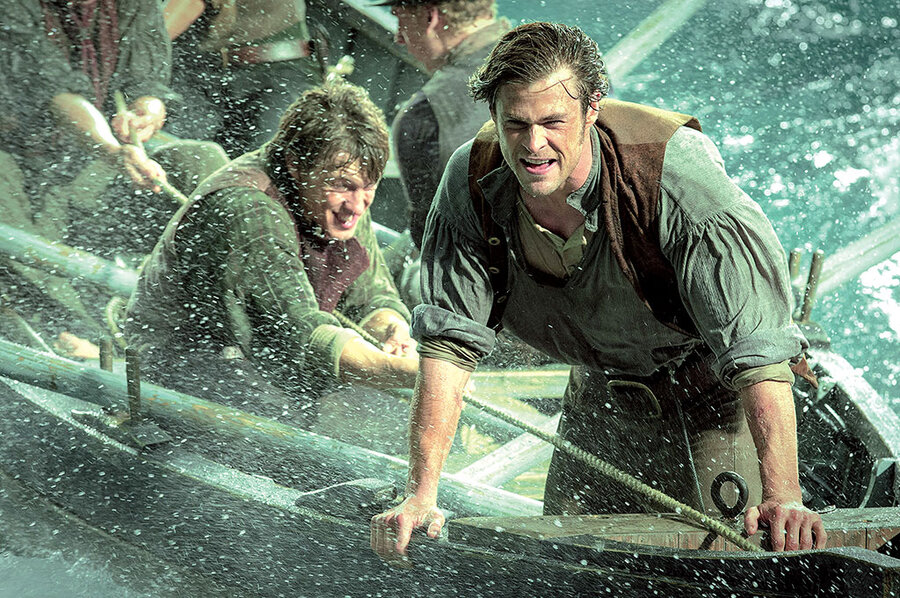'In the Heart of the Sea' is serviceable but mostly unstirring
Loading...
I’m a sucker for 19th-century seafaring movies, especially ones in which the words “Thar she blows” can be heard above the din. This is not to say that such movies, by definition, are good. Case in point: Ron Howard’s “In the Heart of the Sea,” a serviceable but mostly unstirring adaptation of Nathaniel Philbrick’s eponymous 2000 nonfiction bestseller, which had as its subtitle, “The Tragedy of the Whaleship Essex.” But I’m pretty sure I heard someone from the topmast yell out “Thar she blows,” so that counts for a lot.
The New England whaling ship Essex was attacked in the South Pacific in 1820 by a gigantic white leviathan, capsizing the ship; only a handful of the crew survived after months lost at sea. Does any of this sound familiar? The film’s flash-forward/flashback conceit, scripted by Charles Leavitt, is that, 30 years later, the young novelist Herman Melville bribes the Essex’s sole living survivor, Tom Nickerson (Brendan Gleeson), to unload to him the true story, as opposed to the whitewashed official version, of what happened aboard the Essex and its aftermath. It seems Melville has a novel he wishes to write but needs a bit more deep background.
This framing device is apocryphal, of course. Melville knew of the Essex but “Moby-Dick,” that peerless masterpiece of Shakespearean proportions, draws hardly at all on the details of that whaling ship’s fate. Essentially, what the two narratives share is a white whale, and the whale in “In the Heart of the Sea,” when it finally flares its flukes, is actually kind of mottled – off-white with greenish-gray accents.
Howard directs the movie as if, except for the CGI effects, he were an old studio hand in the Golden Age of Hollywood. “In the Heart of the Sea” would not look out of place in the same stiff, stalwart company as “Captains Courageous” or the Clark Gable-Charles Laughton “Mutiny on the Bounty” (though not with John Huston’s “Moby Dick,” a far more powerful experience).
The real ocean battle, at least until the big guy shows up, is not with a whale but between the Essex’s clueless high-born Captain George Pollard (Benjamin Walker), whose lineage unfairly qualifies him for the post, and his first mate, Owen Chase (Chris Hemsworth), who by all rights, except, alas, his low-born birth, should be commanding the ship. It’s the haves versus the have-nots, which I suppose has a contemporaneous cachet, as does the film’s depiction of the apocalyptically awful lengths people will go to in order to keep their homes heated. (Just substitute fossil fuels for whale oil.) But thankfully Howard doesn’t push the then-and-now comparisons, preferring to stick with more palatable material, such as the young Nickerson (Tom Holland) descending into the gross, gooey innards of a harpooned whale. Later on, the men, lost at sea, cozy up to cannibalism.
The white whale of this movie is a “Jaws”-style attack machine, so I guess there’s an eco-terrorist side to this story as well. The whale is telling the Essex crew in no uncertain terms not to mess with Mother Nature. Despite Chase’s stirring exhortations – my favorite: “As I live and breathe, he’s mine!” – I often found myself rooting for the whale. I never felt this way about the great white shark in “Jaws,” except, possibly, when he dined on Robert Shaw.
They don’t make these kinds of “Thar she blows” movies much anymore, at least not unless they star Russell Crowe, so I guess there are nostalgic pleasures to be had here. The film is uninspiringly OK, and if you close your eyes, or, better yet, if you open them, you might just believe you had been transported back to 1930s Hollywood. If the movie accomplishes nothing else, though, I hope it inspires the curious to actually sit down and finally read “Moby-Dick.” It’s an extraordinary yarn. Really. Grade: C+ (Rated PG-13 for intense sequences of action and peril, brief startling violence, and thematic material.)







